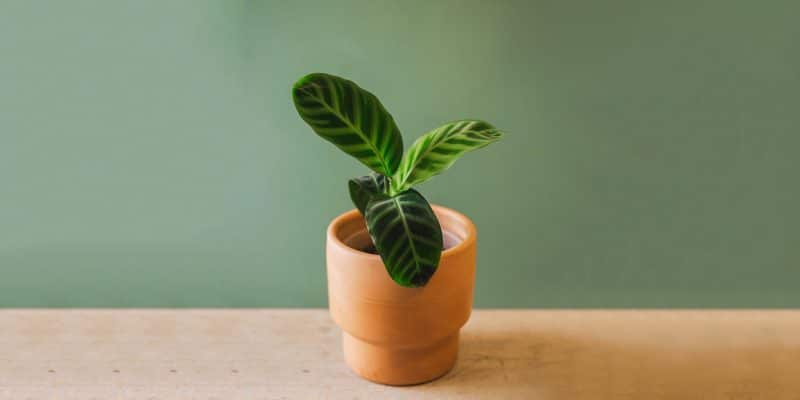Calathea zebrina, well known by its common name, zebra plant, is not only strikingly beautiful, but also has a bit of a wild side. So, if you’re looking to bring a piece of the exotic indoors, you’ve come to the right place!
Zebra plant, with its vibrant green leaves and bold, dark stripes, will undoubtedly add a pop of color and life to any room it graces. And if you believe in the air purifying qualities of plants, you’ll love that this species is reportedly one of the best.
In this article, we’ll dive deep into the world of Calathea zebrina care, guiding you through everything you need to know about this gorgeous houseplant.
Table of Contents
Calathea Zebrina Plant Care Guide
History, habitat, and characteristics
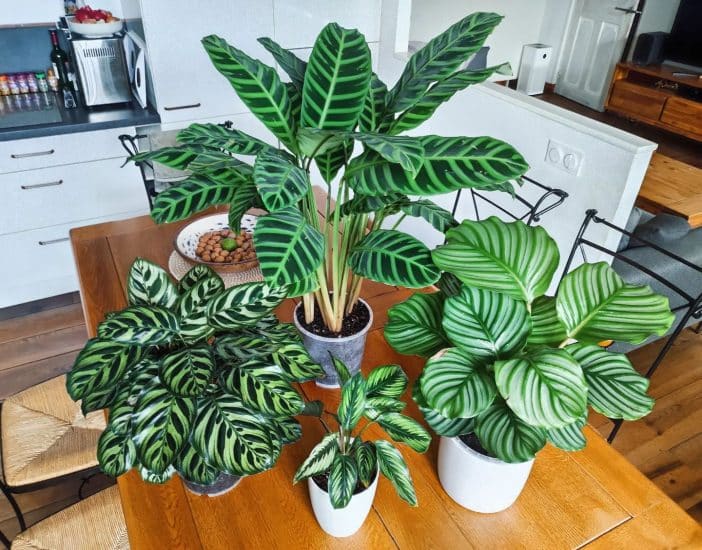
Calathea zebrina (now being reclassified as Goeppertia zebrina) hails from the enchanting rainforests of southeastern Brazil. Native to tropical regions like Rio de Janeiro, São Paulo, and Florianópolis, Calathea zebrina is a proud member of the prayer plant family, Marantaceae.
Some houseplant enthusiasts might think of Calathea zebrina as a bit of a drama queen in the plant world, but it’s well worth the effort. Show it some love, and it’ll reward you with lush, full growth. In its home environment, this rhizomatic species reaches heights of 12 to 18 inches and can spread up to 3 feet wide by forming attractive clumps.
Now, for a rare treat — if you’re lucky enough to see your indoor Calathea zebrina bloom, you’re in for a visual feast! Its delicate purple or white flowers resemble tiny baskets, which give rise to its name from the Latin-by-way-of-Greek word “calathus,” meaning “basket.”
(Fun fact: It gets the “prayer” title from its leaves folding up like praying hands every evening.)
Light
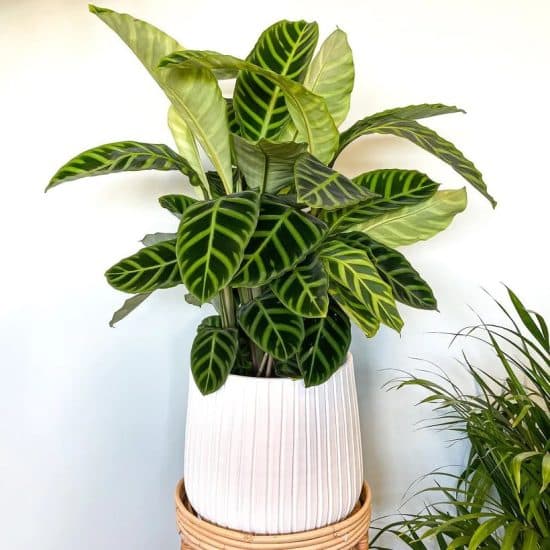
This tropical plant grows natively beneath the canopies of the rainforest, so it loves moderate, filtered light conditions and will do well with indirect sunlight. Keep it near a window but a bit to the side, shielded by curtains or other plants so it’s protected from direct sunlight — harsh rays can cause leaf burn.
If your zebra plant isn’t receiving sufficient light, it may show signs of slow or leggy growth, reaching out toward its light source. In more severe cases, the leaves might lose some of their vibrant color and distinct dark green stripes.
However, if your plant is exposed to excessive direct sunlight, its leaves could burn. In such cases, you may observe fading, scorching, or brown patches. To avoid this, make sure your Calathea is protected from harsh direct sunlight.
Our light tips:
- Position your plant in a well-lit area but shield it from direct sunlight, either with a sheer curtain or by placing it off to one side of a window.
- Rotate your plant every now and then to ensure even growth and balanced exposure to light.
- For rooms with limited natural light, use an LED grow light.
Water
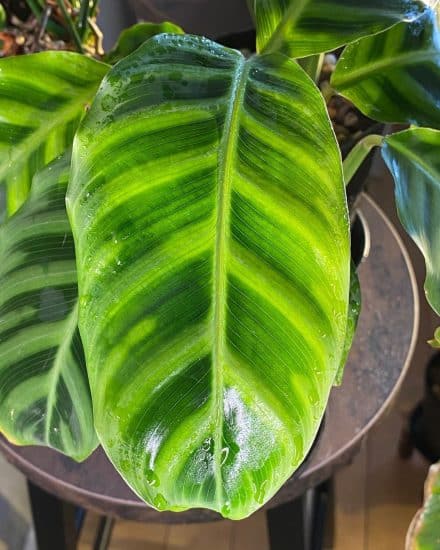
The zebra plant prefers consistent moisture without being drenched. This balance is crucial to keeping your Calathea zebrina healthy and thriving.
Opt for small, frequent servings, rather than one big deluge. Rather than regular watering, which can lead to overwatering, feel the soil and water just before it starts to dry out. Using filtered or rainwater instead of tap water can help keep those lovely striped leaves free from brown tips.
When your Calathea zebrina isn’t getting enough water, the leaves will curl up and turn crispy. Make sure your Calathea zebrina isn’t positioned near heat sources or drafts, which can cause it to dry out.
On the other hand, too much water can be detrimental to your plant’s health, leading to soggy soil and waterlogged roots. This is often indicated by mushy stems and limp, yellowing leaves. If you notice this happening, ease up on your watering routine.
Our water tips:
- Water your Calathea zebrina in small amounts frequently, ensuring the soil is consistently moist but never wet.
- Reduce watering in the winter months.
- Use filtered or rainwater when possible to avoid browning and crisping on the leaves’ edges.
Temperature and humidity
Calathea zebrina prefers a consistently warm environment that mimics the tropical rainforest it originates from, so keep the temperature around 70°F year-round. Watch out for cold drafts and temperature fluctuations — these can cause stress to the zebra plant and affect its growth.
To maintain optimal humidity, try grouping the plant with other humidity-loving plants, or using a pebble tray filled with water to increase humidity. Just be sure to use enough pebbles so that the roots are never sitting in water.
Alternatively, you could use a humidifier. Place a humidifier near your Calathea zebrina and run it at least 6 hours a day to maintain higher humidity levels. Especially in dry climates, the use of humidifiers provides extra moisture for tropical plants.
While an enjoyable pastime for houseplant lovers, misting is not an effective method of increasing humidity. You would need to mist consistently for extended periods for it to be effective — it’s nearly impossible.
Our tips:
- Keep Calathea zebrina in temperatures around 70°F and protect it from cold drafts or sudden temperature changes.
- Aim for a humidity level of at least 40%, adjusting as needed to keep the plant happy.
- Group your zebra plant with other humidity-loving plants and use a pebble tray or humidifier to maintain humidity.
Soil and planting
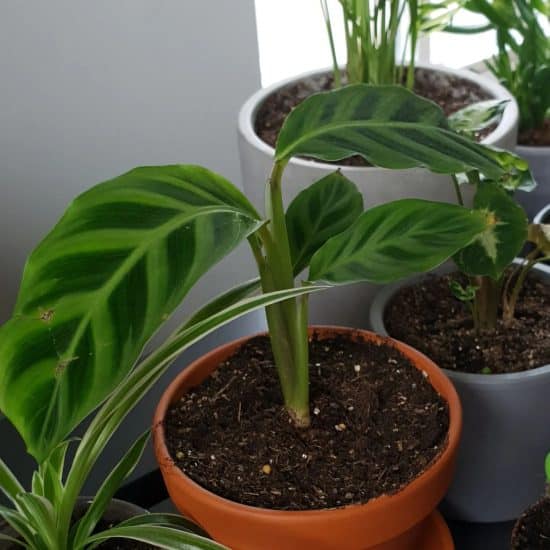
Caring for your Calathea zebrina starts with creating the ideal environment for its root system. To do this, use a suitable soil mixture that retains moisture while also providing excellent drainage and aeration. A combination of coconut coir and perlite mixed into your potting soil can achieve this.
If you notice your Calathea zebrina’s leaves looking yellow or wilting, this could be a sign of poor soil conditions. Roots may become waterlogged in wet soil that doesn’t drain well, leading to root rot.
On the other hand, a soil mixture that dries out too quickly may cause the plant to become dehydrated and stressed. Adjusting the soil composition by adding more perlite or coco coir (depending on the issue) can amend this situation.
Choose a pot with good drainage that won’t remain cold for long periods, such as a plastic container rather than a terracotta pot.
Calathea plants don’t like to be root bound, nor do they like their roots being disturbed. This may be one reason calatheas are known to be drama queens. Keep your calathea in its original pot as long as possible, and when necessary, repot the plant during a growth period, ideally every two to three years.
Fertilize your zebra plant every two weeks with a liquid fertilizer, but use a lower dosage than the recommendation on the fertilizer bottle. This will ensure the plant receives the necessary nutrients without overwhelming it.
If you spot yellowing or brown leaf tips, slow growth, or root burn, these could be signs that you have over-fertilized your Calathea zebrina. To resolve this issue, flush the soil with water to wash away excess fertilizer, and reduce the fertilizer dosage or watering frequency in the future.
Pro tip: If you’re still struggling with soil and fertilization, you may want to consider moving your Calathea zebrina to LECA (lightweight expanded clay aggregate). This alternative growing medium provides excellent drainage, aeration, and a buffered environment, reducing the risk of root rot and over-fertilization.
Propagation
Propagating your Calathea zebrina is pretty straightforward, and it’s a fantastic way to grow your plant family or share the love with friends! The go-to technique for propagating this beauty is rhizome division.
Propagating Calathea zebrina with rhizome division:
- Timing is everything: The ideal time for propagating your zebra plant is during its growing season. Spring or early summer, when your plant is full of energy and ready to create new plant buddies, is ideal.
- Gather up the essentials: Before you start, make sure you have a clean, sharp pair of scissors or a knife, some pots for the smaller zebra plants, and a fresh batch of well-draining potting soil.
- Remove the mother plant from its pot: Gently take your zebra plant out of its current pot for a close look at those rhizomes and clumps.
- Spot those rhizomes and clumps: Inspect the root ball and hunt for the rhizomes (horizontal stems growing just below or at the soil surface) and the clumps they form.
- Divide and conquer: With clean, sharp scissors or a knife, separate the clumps. Keep as many roots intact as you can during this process — the more roots, the merrier!
- Pot ’em up: Fill your new pots with your well-draining potting soil and dig a little hole in the center. Place each division in its own pot, covering the rhizomes with soil. Press the soil gently around the base of the new plant to give it the support it needs.
- Water and pamper: Give each new zebra plant a good watering, letting the excess water drain to keep the soil moist. Put your new plants in a spot with bright, indirect light, and keep their watering schedule consistent for healthy growth.
Common Issues
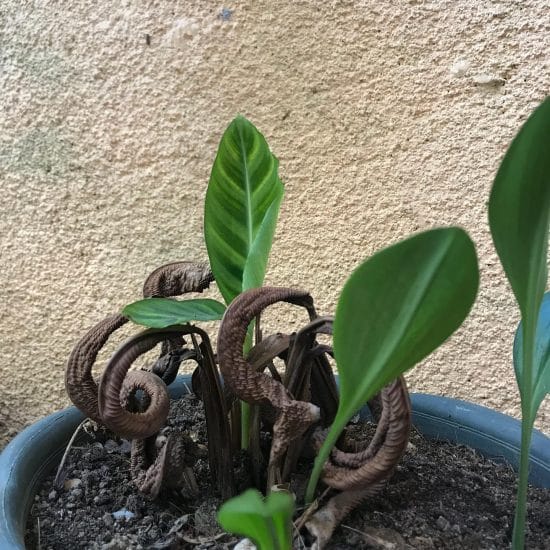
Sensitivity to replanting or moving the plant
Calathea zebrina can be quite sensitive to changes in its environment, just like us when we move to a new place! So, when you repot or move your zebra plant, keep an eye out for signs of stress, such as droopy leaves, limp stems, or slowed growth. Don’t worry, it’s totally normal for your Calathea zebrina to take some time to acclimate to its new environment.
Think of your Calathea zebrina like a friend that needs a little extra care during times of change. To help it adjust to new surroundings, make sure it has everything it needs: proper lighting, more humidity, and a warm climate. Patience is key here . . . It can take 4 to 6 weeks for the plant to adapt to new conditions.
Pro tip: Avoid too much change at once. If you’ve just repotted your zebra plant, don’t change its sun exposure. Conversely, if you’re going to move your plant to a new location, don’t repot it or change its watering routine for a while.
Brown, crispy leaf edges
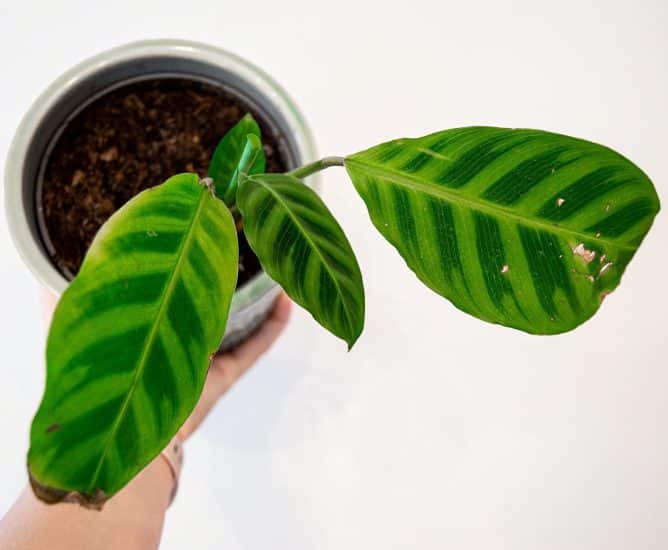
If you’ve noticed brown, crispy edges on your Calathea zebrina’s leaves, it’s probably throwing a little tantrum about tap water or not having enough humidity. Tap water often contains minerals and chemicals that can build up in the soil and harm the plant. Plus, low humidity can lead to leaf dehydration, causing those crispy, brown edges.
First things first, get your zebra plant some better water. Try using filtered, distilled, or rainwater instead of tap water for your Calathea zebrina. It’s like giving your plant a refreshing beverage, free from harsh chemicals and minerals.
Next, create a spa-like environment for your plant by boosting the humidity. You can place a humidifier nearby or group it with other humidity-loving plants (the more, the merrier). A pebble tray filled with water will increase the ambient humidity of the air around the plant as the water evaporates.
Pests and diseases
Pests
Calathea plants can be prone to pests when not cared for properly. Even if you’ve been doing a great job keeping your Calathea zebrina healthy, spider mites, mealybugs, or aphids might still crash the party. Keep an eye out for any small bugs, webbing under the leaves, or little cotton-ball-like growths.
To evict unwanted guests, first, move your plant away from other plants to prevent spreading. Then, use a damp cloth to gently wipe the pests off the leaves and stems. If the problem persists, try using a biological insecticide such as neem oil (follow the instructions) or mix some rainwater with a bit of dishwashing liquid and lightly spray your plant.
To keep those pests away for good, wipe the leaves every two weeks with filtered water or rainwater and dishwashing liquid mix. Trust us, your plant will thank you!
Root Rot
Overwatering and poor soil drainage cause roots to sit in water and eventually rot. To spot root rot, look for wilting leaves, a mushy base, and a foul smell from the soil. Gently take your plant out of its pot and inspect the roots for any dark, slimy, and mushy parts.
Here’s how to fix it:
- Sterilize a pair of scissors or pruning shears and trim off the affected roots. Be thorough to give your plant a fresh start.
- Clean the pot (leaving it out in the sun works great) or use a new one with proper drainage holes.
- Repot your plant in a fresh, well-draining potting mix. Add some perlite or pumice for better aeration.
- Water your plant sparingly for a while, letting the soil dry out between waterings.
Conclusion
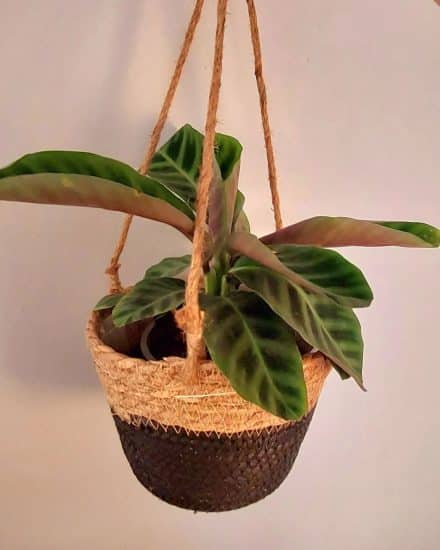
That’s a wrap for our zebra plant care guide! With this newfound knowledge, you’ll be able to bring the enchanting beauty of the Brazilian rainforests right into your home.
Our Calathea zebrina care tips:
- Provide moderate, indirect light conditions and avoid harsh direct sunlight to prevent leaf burn.
- Water your plant frequently but in small amounts, ensuring consistently moist soil without overwatering.
- Keep the temperature around 70°F and humidity levels at least at 40%, adjusting as needed for your plant’s comfort.
- Use a well-draining soil mixture and the right pot, and fertilize at a low dosage regularly to ensure optimal growth.
- Propagate through rhizome division and be patient as your new plants adjust to their environment.
We hope this guide has helped you and provided the tools you need to care for your Calathea zebrina. As always, if you have any questions or need further assistance, feel free to reach out to us. If you enjoyed this guide, don’t forget to share it with your fellow plant fans!
Take care, and happy planting!
FAQ
Is Calathea zebrina hard to care for?
Calathea zebrina might be a bit of a diva when it comes to care requirements, but it’s well worth the extra attention. With some dedication and an understanding of its preferences, you’ll be able to keep it happy and healthy. It requires consistent temperature, humidity, and watering to thrive.
Which plant is the zebra plant?
There are actually several plants with this name. While Calathea zebrina is one of them, others include Aphelandra squarrosa and Haworthiopsis attenuata.
Aphelandra squarrosa: Native to Brazil and characterized by glossy green leaves with white veins, it also produces showy yellow flowers that make it a popular ornamental plant.
Haworthiopsis attenuata: Also known as the zebra cactus or zebra haworthia, this is a small succulent native to South Africa. It belongs to the Asphodelaceae family and is characterized by thick, fleshy, green leaves with distinctive white horizontal stripes, giving it the appearance of zebra stripes.
Are Calathea zebrina plants toxic to pets?
Calathea zebrina is considered nontoxic to pets, making it a safe choice for homes with furry companions, according to the ASPCA. However, it’s still a good idea to keep an eye on your pets around houseplants because chewing on leaves can cause digestive issues.

